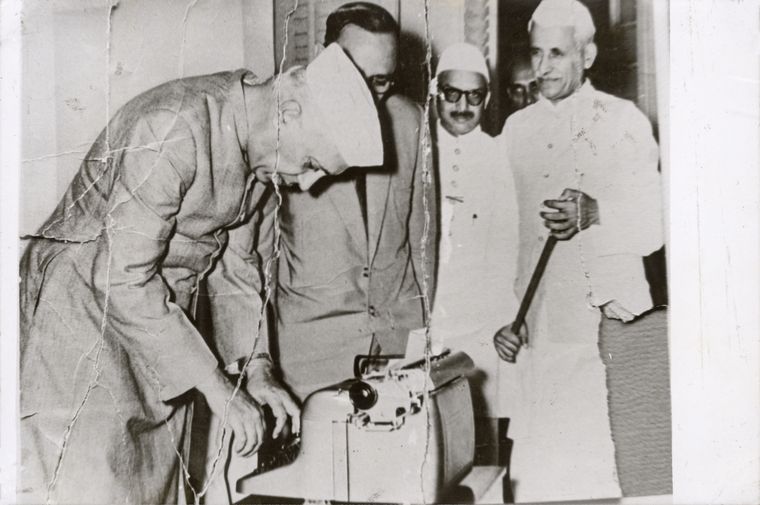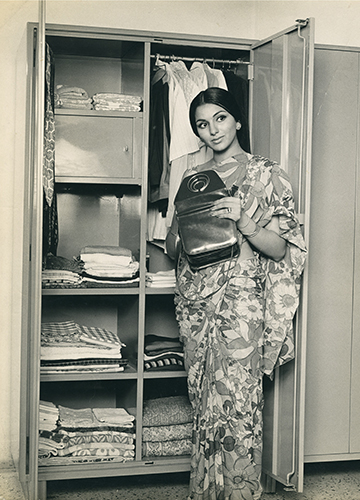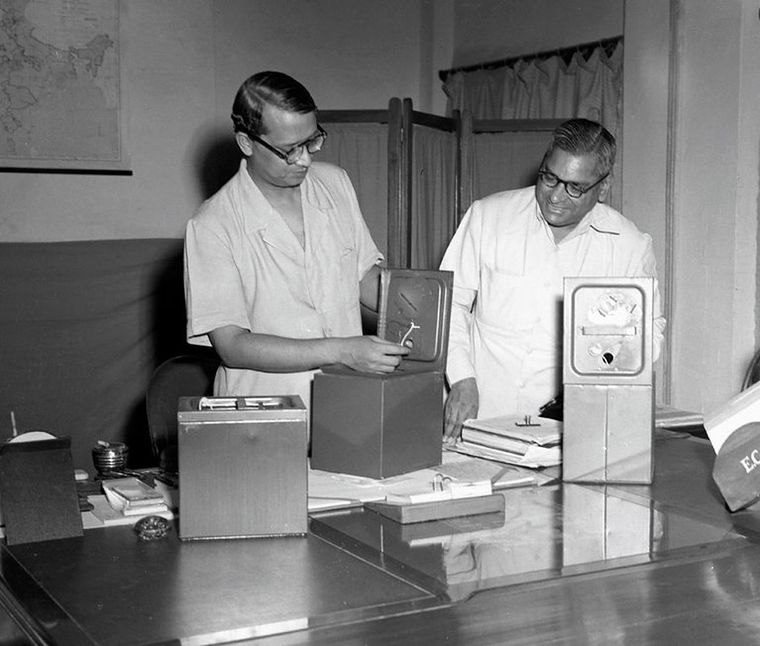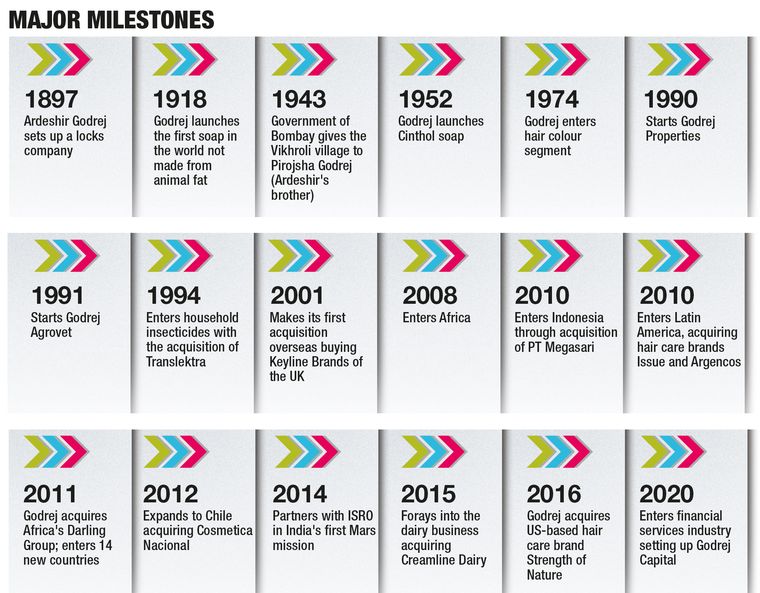It was at the turn of the century―1897. The year Bram Stoker’s Dracula offered a blood drinking afterlife; Oscar Wilde was released from prison for gross indecency; the Battle of Saragarhi―much before its very nationalist Kesari (filmic) avatar―was fought to be lost; and a young Parsi, Ardeshir B. Godrej, set up a lock factory that was key to India’s safe future.
“We cannot call it a startup, but in a way it was,” said Vrunda Pathare, head of Godrej Archives. Till Ardeshir chose to go the security way, factory-made locks were imported; Indian locks were handmade. His was the first made-in-India endeavour that changed not just the lock landscape, but also our history. By 1908, Godrej had patented the first springless lock in the world. And by 1911, when King George V and Queen Mary became the first monarchs to set foot on Indian soil, their valuables were stored in Godrej safes―an endorsement that was as solid as the safes.
It is Monday morning―the heat is as thick as the sugar in the Irani chai Mumbai is famous for. The Godrej Archives at Plant 19A of the Godrej and Boyce headquarters in Vikhroli is open. Workers, in blue uniforms, are at work in a shed next door. The clang of metal with the factory siren provides the background score for researchers―a reminder that the past is a hammer tap away from the present. From the patent of the first lock to the first-ever made-in-India typewriter―beating the competition from the imported Remington―to keeping records of its aerospace and defence achievements, the archives trace the progress of Godrej. But dig deeper, and these objects, be it the steel cupboard―an essential part of the Indian trousseau―or the office chair, which became a staple in corporate India, or the ultra-low temperature freezers for storing Covid-19 vaccines, also hold a nugget of the country’s history that lies off the beaten track of mainstream history.
And, it began with a tiny metal object designed to resist theft, but instead became the symbol of resistance―the Godrej lock. Getting Ardeshir to open up for an interview was as difficult as picking his pioneering lock (one version even had a sort of a lie detector). The only surviving interview of his is the one he gave The Herald on April 27, 1927, which referred to him as a “crank”. His passion for his product, and his patriotism, clearly shows. “Ye asses and donkeys, ye foolish children of India, what have you done for the Swadeshi industries?” he said. “If you see your mother bleeding in so many parts of her body, will you leave her alone and enjoy living your life at her cost?” He was 62 then and had spent more than half his life choosing to manufacture in India and for India. He refused to pose for a picture for the newspaper. The journalist notes that he was fiddling with scent bottles during the interview.
Perfume was part of another pet project―swadeshi soap, a sort of patriotism test by bubbles. Soap would perhaps never have been counted as a symbol of independence. But Godrej’s No. 2 certainly was, at least for Ardeshir. At the 1906 Calcutta session of the Congress, all attendees vowed to boycott British goods. The first vegetarian soap was thought of by Ardeshir. Much before its Cinthol, which had the rugged Vinod Khanna as the model, and Crowning Glory, with the glorious mane of Dimple Kapadia, Godrej’s vegetarian soap was endorsed by Nobel laureate Rabindranath Tagore. No ekla chalo mantra for this bar, it also had a supporter in Dr Annie Besant. Soon, it became part of households across India, outselling Lux, White Rose, Cuticura and Windsor. Godrej No. 2 was followed by a rose-scented No. 1.
Swept up in the spirit of freedom, Ardeshir, who had failed as a lawyer, knew that business could be for change and embraced swadeshi as a mantra. There was an attempt to manufacture surgical instruments for hospitals at a fraction of the price. It had come to naught. He was unwilling to do the only request the hospital had―print ‘Made in England’ on the instruments. True freedom for India, Ardeshir felt, was to be self-reliant. It was personal as much as it was political.
When his locks were ready for the market in 1901, he found that British-owned papers refused to carry advertisements objecting to the phrase ‘as good as imported variety’. Only Indian papers like Kesari, Tribune and Bombay Samachar chose to carry his advertisement (he later donated Rs 3 lakh to The Tilak Swaraj Fund in memory of Kesari founder Bal Gangadhar Tilak). Posters were put up at eating houses, railway stations and meeting houses. By 1902, he had used his expertise of the impregnable to create safes. And to prove just how safe they were, they were tested by fire.
The remnant of a Re 1 note―rescued from the Godrej office in Lalbaug―is a tangible testimony to the effectiveness of the safe. It is also a reminder of how the story of Godrej is enmeshed in the fabric of the city by the sea. The note is a witness to the deadliest fire that Bombay, a century before it became Mumbai, ever saw. In 1944, SS Fort Stikine docked at Bombay. It was at the end of World War II, and the ship was a floating tinder box carrying ammunition, spares for ships and aircraft, gold bars, besides a fighter plane and flammable cargo (cotton bales, cartons of oil, resin, scrap iron and sulphur) from Karachi. As the ship was waiting to be unloaded, a small fire started on April 14. While the crew on the ship tried to douse the fire, two explosions were heard by 4pm (the impact was so severe that it was registered on the seismograph). It took the fire department three days to bring the fire under control. The official death toll stands over 700. It took over 8,000 people seven months to remove five lakh tonne of debris and get the docks back in working order. April 14 is now observed as National Fire Service Day.
“What was kept in the Godrej safe was all that could be retrieved from that fire,” said Pathare. “So, there are all these stories that say that some safes were flung into the air, but still they only got a dent. Everything that was inside was intact. This is the Rs1 note that was found in one of the safes.”
This is not the only impact that the company has had on the city’s landscape. In the 1960s and 1970s, as Bombay strove to challenge the sky and create office space at Nariman Point, the inching up was supported by Godrej. “At that time, Godrej was into the business of architectural fabrication, which was mostly steel windows and door frames,” said Pathare. “If you go to the campus of Tata Institute of Fundamental Research at Colaba in Mumbai, you will find that all the window frames with aluminium, and the louvres of the library were provided by Godrej.” This Godrej imprint can be found in other important buildings not just in Mumbai, like the Air India building and the Oberoi hotel, but also in other parts of the country, she added.
If the fabric of freedom was handspun khadi, it also had the strength of steel. The Godrej Archives is witness to a changing India―from being an intrinsic part of the country’s Swadeshi Movement against colonialism to being intimately tied with the vote in free India. The first general elections were very much a test for India in the grand experiment of democracy. They lasted five months, from October 1951 to February 1952. It was also very much a trial for Godrej, which was responsible for manufacturing the ballot boxes. India’s first election was a mammoth exercise, with 1,874 candidates and 53 parties. India’s population was 36 crore, and close to half―over 17 crore―were voters. The task was daunting. The Vikhroli plant―Ardeshir’s brother Pirojsha purchased it in 1943, as the mill areas in Lalbaug and Parel were proving too small for dreams―that stood in the middle of green fields operated round the clock to create ballot boxes as tamper-proof as their safes. “Mr Thanewalla, who oversaw Plant 1 (in Vikhroli), said that workers would sleep at the plant, as this was a very important order for them,” said Pathare.
The archives hold in its collection the advertisement of 1951― ‘Every Vote Counts’―that mentions that 12.83 lakh boxes were made then as well as a note on the locking mechanism used. There was a lot at stake. The boxes had to be not only tamper-proof, but also waterproof and vermin-proof. After creating more than 70 prototypes―the number reveals just how invested they were in the process―they arrived at the perfect box.
“We have a circular regarding railway wagons dispatching ballot boxes to different parts of India,” said Pathare. “The internal locking mechanism was a patented invention, as we are told. The locking mechanism was made for these ballot boxes because the external locks were more expensive than the manufacturing cost of this box, which was Rs5. So they thought of reducing the costs by providing the internal locking mechanism.” One could just put a seal on the box when locked internally. A Godrej worker named Nathalal Panchal developed this mechanism, she added. It is a name that is not even a footnote in the country’s history, but nonetheless known, thanks to Godrej’s oral history―passed down by employees over the years and now recorded in the archives (Godrej is one of the first few corporates to invest in preserving its history).
Steel was at the heart of new India―outside buildings, in homes and also to build dreams beyond the stars. And, it is here that the typewriter, the first machine that embraced and defined officialdom, helped lay the foundations. It is lessons learnt from this machine that helped cement the company’s relationship with India’s space journey―from developing high-precision satellite components for an Indian Space Research Organisation launch in 1985 and later being a crucial part of ISRO’s many missions, including Mangalyaan and Chandrayaan, to building critical parts of the Tejas light combat aircraft, to developing the new automated assembly line for the Pinaka rockets for the Indian Army in 2020 and even the cladding of the BrahMoS.
But it all started with the first swadeshi typewriter in independent India in 1955. The typewriter became a symbol of changing demographics in offices, ushering in a generation of women typists by offering them a chance at a career outside homes. “Naval Godrej (Pirojsha’s son) was the man behind the typewriter,” said Pathare. “He went to his father, saying he wanted to make a typewriter. Pirojsha, for whom quality was important, asked whether we would be as good as Remington, as it was a standard for quality in typewriter manufacturing.”
It was a challenge, as it took quite a while and many avatars before the bestseller was discovered. From being providers of locks and safes, the company had moved to precision engineering. “At that time, none of the Indian companies were manufacturing typewriters,” said Pathare. “That is why, Pirojsha was actually sceptical. We had never manufactured such parts, as our expertise till then was in sheet metal work. This was a risk. This machine had some 1,800 to 2,000 smaller parts.”
Yet, Naval, who joined the company at 17 without going to college, was confident they could pull it off. Pathare recounted a conversation with S.M. Vaidya, who used to head Godrej Aerospace. He was asked what his favourite machine was, and they thought he would pick something from the space industry. “But he mentioned the typewriter,” said Pathare. “The typewriter marked the beginning of precision engineering, as this machine gave us the confidence for the precision required in aerospace.” This helped the company take flight.
The Godrej story, however, is grounded in day-to-day living, too. It is very much represented by the two essential products that became part of middle class India: the fridge and the steel almirah. These two moved the company from outside spaces into homes. “It was only around the 1960s when the middle classes started emerging,” said Pathare. Yet, it was also a time of restrictions. The production of cupboards was limited and people had to book their Storwel almost nine months in advance. “People were ready to wait because by then Godrej was becoming [a symbol of trust],” said Pathare. “People were ready to invest, even if it wasn’t really a very cheap product. But this was in that generation. They wanted to buy a product, invest in it.”
The cupboard or the fridge often moved from being just a gadget to a memory. At the Godrej Archives, one of the first few models of the fridge on display is very much a sentimental acquisition. It was transported from Chandigarh a few years ago. The customer had chosen to hang on to it even though it was not frost-free. Godrej launched the first model of the refrigerator in 1959. With its heavy door―which takes an effort to pull, as it was not meant to be opened at a whim―there was also a key; everyone did not have access. The fridge represents a time gone by, where things were meant for a lifetime. Much like the cupboard, now celebrating a century of existence.
“If you have seen the TV advertisements from the 1980s, you will notice that they work with these emotions, and show what a cupboard really means,” said Pathare. So, how did the cupboard end up being a non-negotiable part of the trousseau? Pathare has the answer to that: “I was speaking to a customer, and she mentioned that it was like creating a space for your daughter in that new home. That is why parents gift cupboards. They have no idea what kind of space has been created for the daughter in the new house. So this is for her.”
The swadeshi soap continues to sell in independent India. Godrej Soaps was renamed Godrej industries. The company has branched into chemicals, agriculture, finance and real estate. It continues to make soap.
Godrej & Boyce continues to keep valuables safe. It makes locks, consumer durables and industrial products, and keeps pushing the frontiers of Indian science in space and defence under the leadership of its chairman and managing director, Jamshyd Godrej. His niece and executive director Nyrika Holkar is expected to succeed him.






